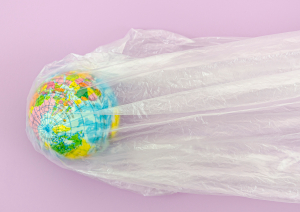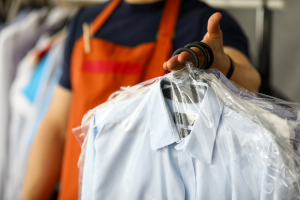Let’s talk packaging


Will there be a future where your dry cleaning doesn’t come back in plastic? At some cleaners this is already the default option, but for many others, going ‘plastic-free’ is an operational nightmare. The Covid-19 pandemic reframed our thinking around product packaging. A McKinsey White Paper on ‘Sustainability in Packaging’ found that post-pandemic consumers ranked sustainability lower than categories like price, quality and hygiene. While the environment is still a leading concern for consumers, recyclable and reusable options need to be easy to find and accessible, in comparison to their disposable counterparts. So, what’s the right way for our businesses to go about it?
Start with a Prescriptive Survey

Before jumping into redesigning all of your packaging procedures, it’s essential to ask your clients what they think. After all, changing your packaging or supplies is a significant financial and operational decision. First, I recommend creating a short survey and sending it out via email or having the survey link embedded in a QR code for clients to scan while they wait in your store. You can create a QR code for free using a site like QR Code Monkey. Simply copy and paste your survey’s URL and select ‘create QR code’.
When creating a survey, I recommend using Typeform because it’s easy to use and offers a variety of question types. Paid plans start as little as $25 and allow you to personalize your survey with your brand colours and business logo. Ask survey questions that elicit a yes or no answer, or that ask clients to rank their preferences. Survey answers from open ended questions like “how do you think we can improve our packaging?” are extremely difficult to synthesize. Before you launch your survey, make sure you decide on the length of time to poll clients; I suggest one to two months.
You Can Start Small

I find our industry (me included) jumps immediately to ‘going plastic-free’ when anything about packaging or sustainability is discussed. Don’t forget, we can start small. A lot of companies use disposable plastic collar stays, cuff and butterfly clips in their shirt department. Consider swapping these for recyclable cardboard or another type of sustainable material. Rather than use disposable shirt bags, perhaps replace paper bags with reusable branded totes. Because most consumers are familiar with a ‘bag fee’, this cost can be passed on to the consumer. Hanger capes also produce a lot of paper waste but can be substituted with a smaller ‘hanger-tag’. Review your packaging process with your production team to spot any opportunities.
If You Go Big

You may instead decide to take a dramatic shift with your packaging and swap traditional poly to a biodegradable option, go ‘no plastic’, or use 2-in-1 garment bags. For most businesses, this is going to be more expensive from both a supply and human resource standpoint, so make sure to do a cost-benefit analysis before you make the leap. I do know of one cleaner who decided to charge its customers 50% more for their ‘no plastic’. At the time, this sounded crazy to me, but he was able to successfully convert 50% of his clients by educating them about the ‘why’ behind the increase. His business is in a very eco-conscious market is and something his clients constantly demanded. A good reminder, listen to your clients.
Market, Market, Market

Whatever you decide to do with your packaging, it’s essential you market these changes to your clients. McKinsey’s survey noted that consumers are willing to pay more for green options, but prefer when they are easily recognizable or available. Unique and sustainable packaging options can be both a retention marketing strategy for existing clients, and prospective selling points to attract new customers. Marketing can take the form of explaining these new changes on your website in a ‘sustainability’ section, through copy in email blasts, or on your Google My Business Page.
Have you made any packaging switches? Share in the comments below.






